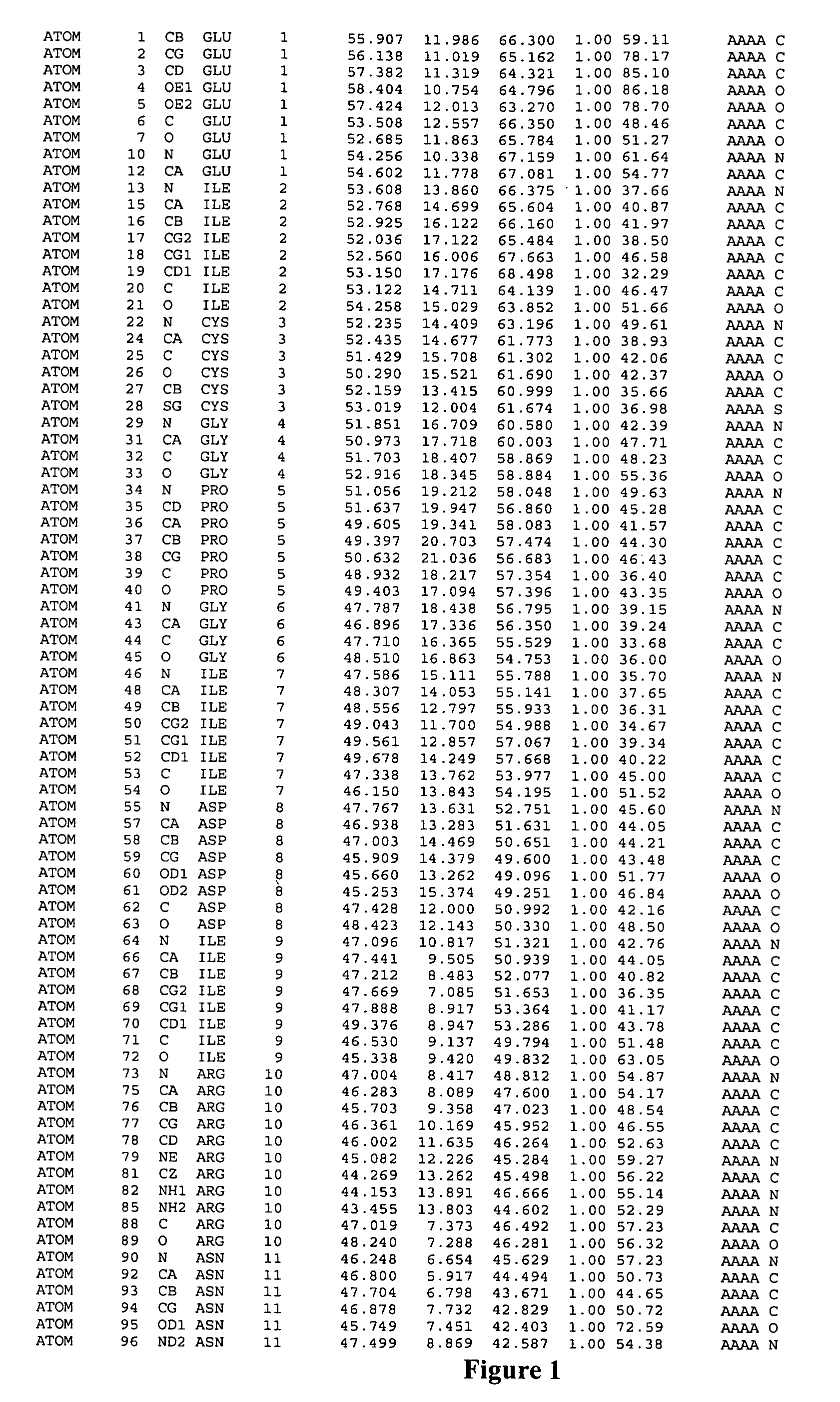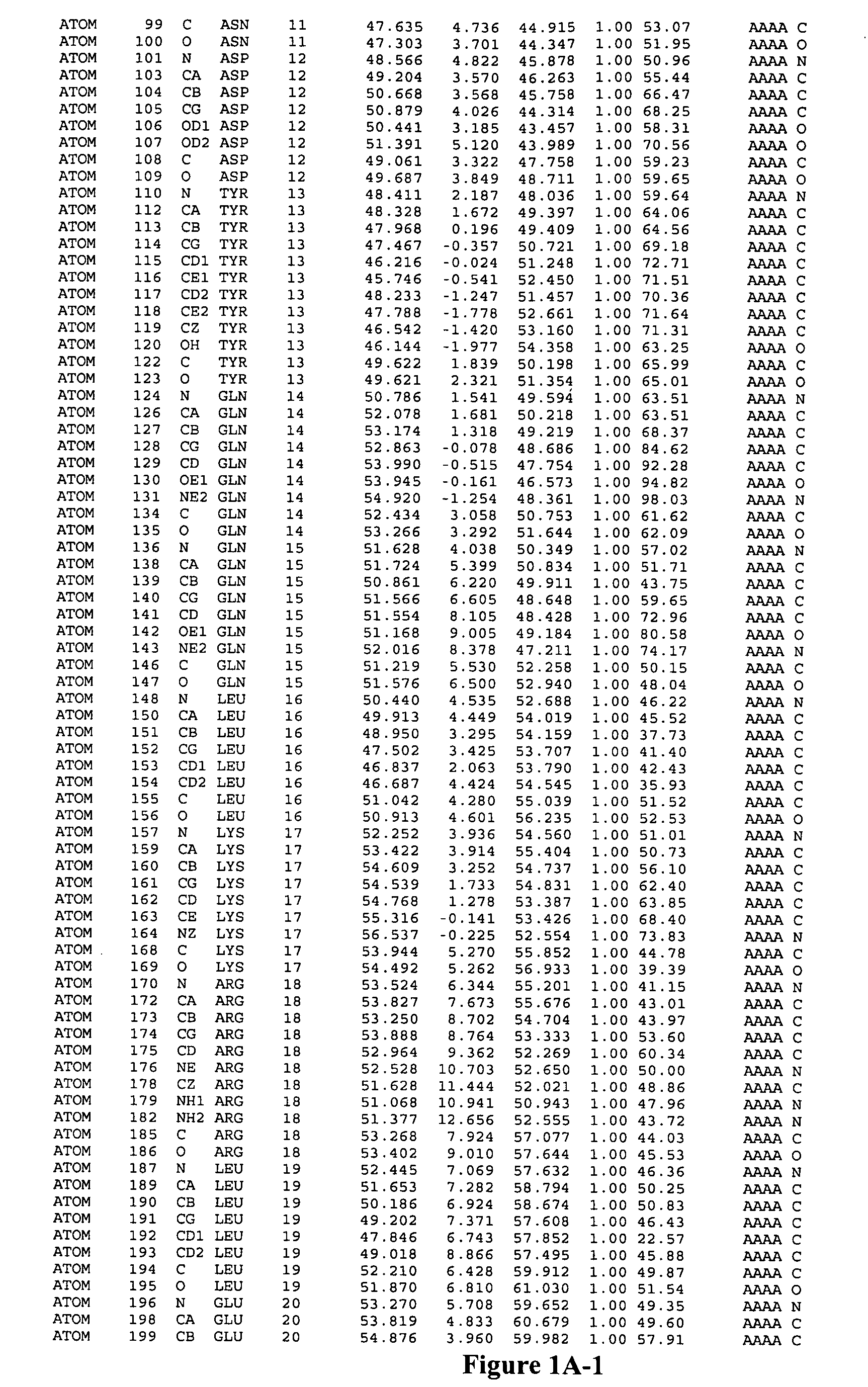Method of designing agonists and antagonists to IGF receptor
a technology of agonists and antagonists, applied in chemical methods analysis, instruments, hormone peptides, etc., can solve the problems of limiting the application of this type of therapy and the cost of humanised monoclonal production
- Summary
- Abstract
- Description
- Claims
- Application Information
AI Technical Summary
Benefits of technology
Problems solved by technology
Method used
Image
Examples
example 1
Expression, Purification and Crystallization of the IGF-1R Fragment.
[0089]Several factors hamper macromolecular crystallization including sample selection, purity, stability, solubility (McPherson, A., et al., 1995, Structure 3:759–768); Gilliland, G. L. & Ladner, J. E., 1996, Curr. Opin. Struct. Biol. 6:595–603), and the nature and extent of glycosylation (Davis, S. J., et al., 1993, Protein Eng. 6:229–232). Initial attempts to obtain structural data from soluble IGF-1R ectodomain (residues 1–906) protein, expressed in Lec8 cells (Stanley, P. 1989, Molec. Cellul. Biol. 9:377–383) and purified by affinity chromatography, produced large, well-formed crystals (1.0 mm×0.2 mm×0.2 mm) which gave no discernible X-ray diffraction pattern (unpublished data). Similar difficulties have been encountered with crystals of the structurally-related epidermal growth factor receptor (EGFR) ectodomain, which diffracted to only 6 Å, insufficient for the determination of an atomic resolution structure ...
example 2
Structure of the IGF-1R / 1-462
[0098]Crystals were cryo-cooled to −170° C. in a mother liquor containing 20% glycerol, 2.2 M ammonium sulfate and 100 mM Tris at pH 8.0. Native and derivative diffraction data were recorded on Rigaku RAXIS IIc or IV area detectors using copper Kα radiation from a Siemens rotating anode generator with Yale / MSC mirroroptics. The space group was P212121 with a=77.39 Å, b=99.72 Å, and c=120.29 Å. Data were reduced using DENZO and SCALEPACK (Otwinowski, Z. & Minor, W., 1996. Mode. Meth. Enzym. 276:307–326). Diffraction was notably anisotropic for all crystals examined.
[0099]Phasing by multiple isomorphous replacement (MIR) was performed with PROTEIN (Steigeman, W. Dissertation (Technical Univ. Munich, 1974) using anomalous scattering for both UO2 and PIP derivatives. Statistics for data collection and phasing are given in Table 1. In the initial MIR map regions of protein and solvent could clearly be seen, but the path of the polypeptide was by no means obvi...
example 3
Prediction of 3D Structure of the Corresponding Domains of IRR and IR Based on Structure of IGF-R Fragment.
[0121]The sequence identities between the different members of the insulin receptor family are sufficient to allow accurate sequence alignments to facilitate 3D structure predictions by homology modelling. The alignments of the ectodomains of human IGF-1R, IR, and IRR are shown in FIG. 9.
PUM
| Property | Measurement | Unit |
|---|---|---|
| pH | aaaaa | aaaaa |
| volume | aaaaa | aaaaa |
| pH | aaaaa | aaaaa |
Abstract
Description
Claims
Application Information
 Login to View More
Login to View More - R&D
- Intellectual Property
- Life Sciences
- Materials
- Tech Scout
- Unparalleled Data Quality
- Higher Quality Content
- 60% Fewer Hallucinations
Browse by: Latest US Patents, China's latest patents, Technical Efficacy Thesaurus, Application Domain, Technology Topic, Popular Technical Reports.
© 2025 PatSnap. All rights reserved.Legal|Privacy policy|Modern Slavery Act Transparency Statement|Sitemap|About US| Contact US: help@patsnap.com



